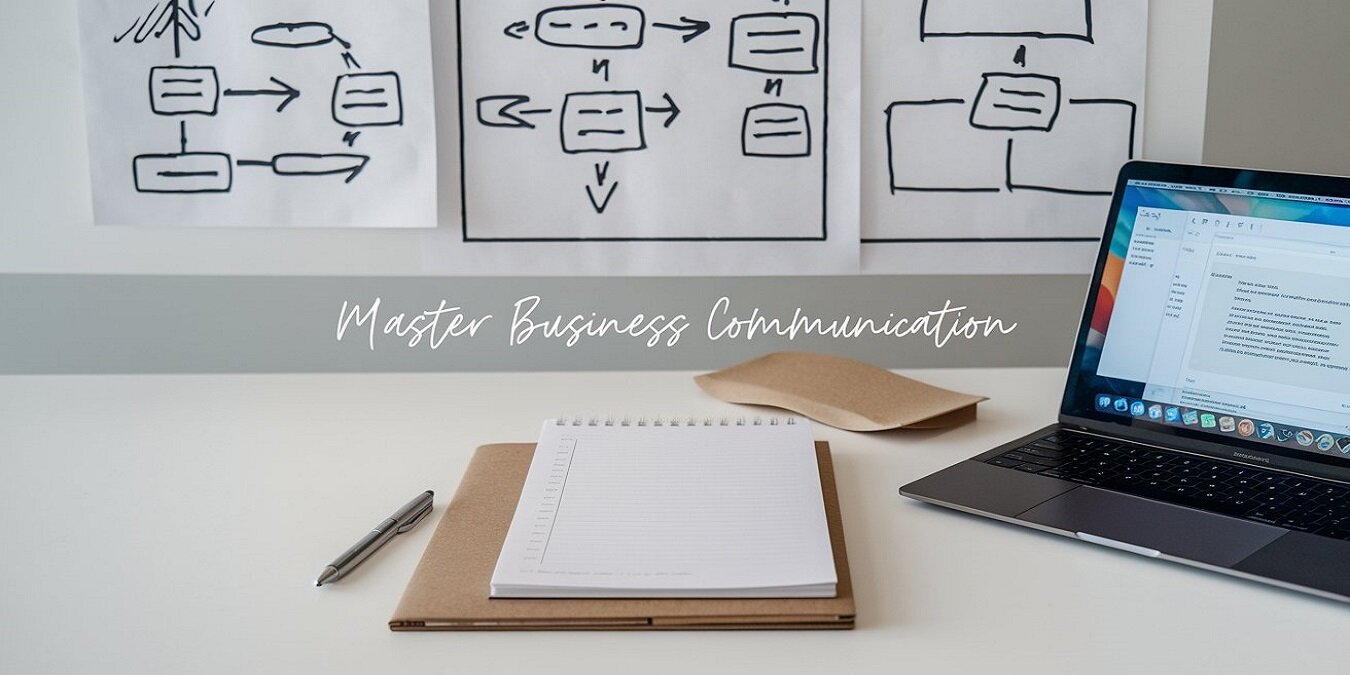
Master Business Communication
What makes some business leaders captivating communicators while others struggle to get their message across? Is it charisma, confidence or just experience? Surprisingly, the secret lies in the art of Business Communication, a skill you can master, too.
Communication in business is not just about delivering information; it’s about delivering impact. Whether you’re pitching an idea, navigating a tough negotiation or even sending an email, the way you communicate can be the difference between success and failure. So how can you master this essential skill?
Why Business Communication Matters
Here’s the thing: Effective communication builds trust, solves problems and fuels growth. In the fast-paced business world, clear, concise and powerful communication helps you stand out. Without it, your ideas, no matter how brilliant, may never see the light of day.
Ready to elevate your business communication skills? Let’s dive into a 30-day plan that will get you there.
Week 1: The Foundations of Business Communication
Day 1: Understanding Communication Types
Start by recognizing the different forms of business communication: verbal, non-verbal, written and visual. Each has its role in business. Identify situations where each form is best suited.
- Task: List communication types and give an example of when you’ve used each. Reflect on which types you are strongest and weakest in.
Day 2: The Art of Listening
Great communicators are first great listeners. Listening builds rapport and gives you insight into what the other person truly needs.
- Task: Spend a day practicing active listening. Paraphrase what someone has said to show understanding and ask clarifying questions.
Day 3: Clarity Over Complexity
Business communication should always prioritize clarity. Often, we overcomplicate ideas, leading to confusion.
- Task: Take a complex topic you understand well and explain it in a single sentence or two.
Day 4: Emotional Intelligence
People don’t just listen to words, they respond to emotion. Understanding emotional cues and responding appropriately is key.
- Task: Reflect on a recent conversation. What emotions did the other person express? How did you respond?
Day 5-6: The Power of Storytelling
Stories make your message relatable and memorable. They simplify complex ideas and captivate your audience.
- Task: Create a brief story that explains a business concept you often deal with. Use it in a conversation or presentation.
Day 7: Crafting Your Message
Always have a clear purpose for communication. What do you want the recipient to think, feel or do after hearing your message?
- Task: Write an email or memo where you focus on a specific goal. Ensure that every sentence contributes toward achieving that goal.
Week 2: Refining Verbal Communication Skills
Day 8: Tone and Language Choices
Your tone can inspire trust or the opposite. It’s not just what you say, but how you say it.
- Task: Record yourself speaking on a business topic. Play it back and pay attention to your tone. Is it engaging? Does it match your intent?
Day 9: Non-Verbal Communication
Body language can say more than words. Posture, gestures and eye contact shape how your message is received.
- Task: Observe the body language of people in a meeting. What can you infer about their thoughts or feelings?
Day 10: Asking the Right Questions
Asking insightful questions helps you get to the heart of a discussion and guides conversations productively.
- Task: In your next meeting, ask three open-ended questions. Aim to encourage deeper thinking and discussion.
Day 11: Brevity and Precision
Long-winded explanations lose impact. Practice cutting out unnecessary details and keeping your message succinct.
- Task: Take an existing email or presentation you’ve created and reduce its length by half while retaining the key message.
Day 12-13: Persuasive Communication
Influence is at the core of business. Whether negotiating or persuading a client, understanding how to present ideas persuasively is essential.
- Task: Learn and apply Cialdini’s principles of persuasion (reciprocity, authority, scarcity, etc.) in your communication.
Day 14: Handling Objections
Not everyone will agree with your ideas. Learning to respond effectively to objections keeps conversations moving forward.
- Task: In your next business conversation, practice handling objections by acknowledging concerns and pivoting toward solutions.
Week 3: Developing Written Communication
Day 15: Structuring Your Writing
Organized writing ensures clarity. Whether it’s an email or a report, a logical structure makes your message easier to digest.
- Task: Write a short memo or email using a clear introduction, body and conclusion. Ensure each paragraph flows naturally to the next.
Day 16: Writing for Impact
Strong verbs, active voice and concise sentences create more impactful writing.
- Task: Revise a piece of writing, cutting out filler words and using strong, direct language.
Day 17: Editing and Proofreading
Typos or unclear sentences can undermine your credibility. Professional writing requires careful proofreading.
- Task: Proofread an important email or document twice, focusing on both clarity and technical correctness.
Day 18: Tone in Writing
Just like in speech, the tone of your writing can vary. Formal reports, casual emails and persuasive proposals all require different tones.
- Task: Write the same message in two different tones – formal and informal. Identify the differences in language choice and structure.
Day 19-20: Email Etiquette
Emails are a cornerstone of business communication. Proper etiquette ensures that your emails are professional and effective.
- Task: Review guidelines for email etiquette (clear subject lines, appropriate salutations, concise body). Apply them to your next business email.
Day 21: Writing a Business Proposal
Business proposals require a mix of persuasion, clarity and structure. Focus on providing value to your audience.
- Task: Draft a simple proposal (real or hypothetical) for a new project, ensuring your points are clear and compelling.
Week 4: Mastering Presentations and Meetings
Day 22-23: Structuring Effective Presentations
Presentations should have a clear goal, strong opening, logical flow and impactful conclusion.
- Task: Outline a presentation, focusing on structure first. Include an introduction, three key points and a conclusion.
Day 24-25: Speaking with Confidence
Confidence comes from preparation. Knowing your material inside out allows you to deliver with authority.
- Task: Rehearse a short presentation. Focus on maintaining a steady pace, clear enunciation and engaging eye contact.
Day 26: Visual Aids
Visual aids can enhance a presentation, but only if used wisely. Keep slides simple and focused on supporting your main message.
- Task: Create three simple slides to accompany a presentation, focusing on minimal text and clear visuals.
Day 27: Managing Q&A Sessions
Handling audience questions during presentations can be daunting. Preparation and poise are key.
- Task: Practice answering tough questions on a topic you’re familiar with. Stay calm, listen carefully and answer clearly.
Day 28: Leading Effective Meetings
Meetings can be a time-waster if not run properly. A strong agenda and clear objectives keep meetings on track.
- Task: Plan and lead a mock meeting. Set an agenda, keep time and make sure every participant’s voice is heard.
Day 29: Constructive Feedback
Giving and receiving feedback is an important business skill. Feedback should be clear, actionable and focused on improvement.
- Task: Provide constructive feedback to a colleague or friend on a presentation or written piece. Focus on both strengths and areas for improvement.
Day 30: Reflection and Assessment
You’ve spent a month improving your communication skills. Now, reflect on what you’ve learned and how you’ve applied it.
- Task: Write a short reflection on how your communication skills have improved and set goals for continuing to grow in this area.
Final Thoughts
Business communication is an ongoing process of learning and refining. It’s not just about mastering the mechanics of language but about understanding how to connect with people. When you become a great communicator, you’ll see doors open, not just in business, but in every aspect of life.
Now, the real question is: Are you ready to take your communication skills to the next level?















Wow! Thank you! I constantly needed to write on my blog something like that. Can I take a part of your post to my site?
I haven¦t checked in here for a while because I thought it was getting boring, but the last several posts are good quality so I guess I¦ll add you back to my daily bloglist. You deserve it my friend :)
As a Newbie, I am continuously browsing online for articles that can benefit me. Thank you
I like the valuable info you provide in your articles. I’ll bookmark your blog and check again here frequently. I’m quite certain I’ll learn plenty of new stuff right here! Best of luck for the next!
But wanna comment on few general things, The website style and design is perfect, the content is real great : D.
I’d have to examine with you here. Which is not one thing I usually do! I take pleasure in reading a post that may make folks think. Additionally, thanks for permitting me to comment!
I must show thanks to the writer just for rescuing me from this situation. Because of researching throughout the the net and seeing tips which are not productive, I believed my life was well over. Being alive minus the answers to the difficulties you have solved as a result of this short article is a serious case, and those which might have badly damaged my entire career if I had not discovered your site. Your actual mastery and kindness in touching almost everything was excellent. I don’t know what I would’ve done if I had not come across such a thing like this. I can also at this point look forward to my future. Thank you so much for your expert and amazing guide. I won’t think twice to refer your blog to any individual who wants and needs direction on this problem.
It is really a nice and useful piece of information. I am glad that you shared this helpful info with us. Please keep us up to date like this. Thanks for sharing.
Thanks for another magnificent article. Where else could anybody get that kind of information in such a perfect way of writing? I have a presentation next week, and I’m on the look for such info.
I’m really inspired with your writing skills and also with the format to your blog. Is this a paid theme or did you modify it your self? Either way keep up the excellent high quality writing, it is rare to peer a nice weblog like this one today..
I don’t unremarkably comment but I gotta say thanks for the post on this great one : D.
It’s hard to find knowledgeable people on this topic, but you sound like you know what you’re talking about! Thanks
This is the right blog for anyone who wants to find out about this topic. You definitely put a new spin on a topic thats been written about for years. Great stuff, just great!
That is really interesting, You’re an overly professional blogger. I have joined your rss feed and stay up for in search of more of your excellent post. Also, I’ve shared your website in my social networks!